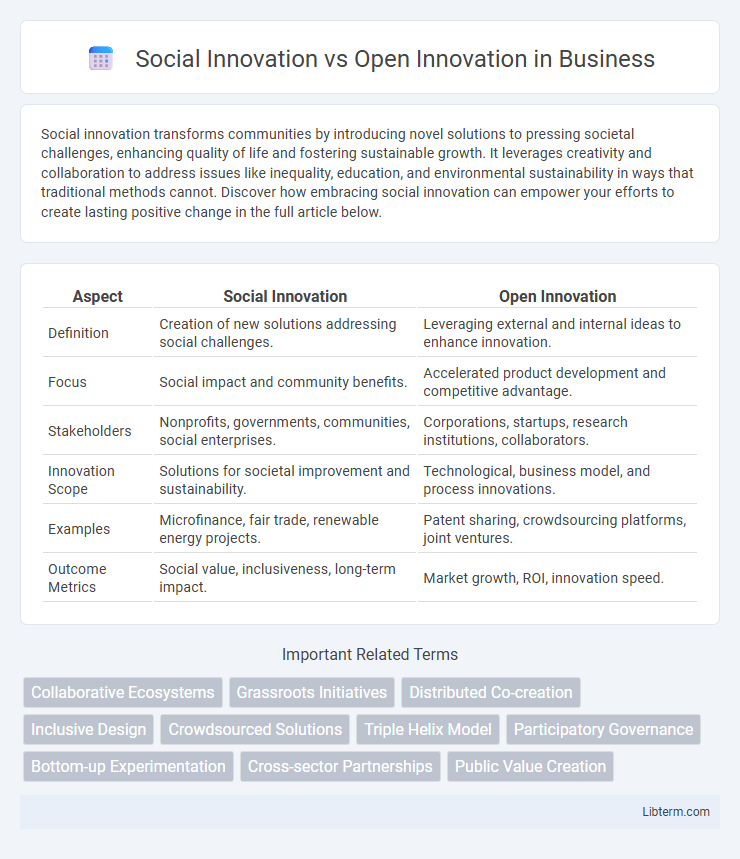Social innovation transforms communities by introducing novel solutions to pressing societal challenges, enhancing quality of life and fostering sustainable growth. It leverages creativity and collaboration to address issues like inequality, education, and environmental sustainability in ways that traditional methods cannot. Discover how embracing social innovation can empower your efforts to create lasting positive change in the full article below.
Table of Comparison
| Aspect | Social Innovation | Open Innovation |
|---|---|---|
| Definition | Creation of new solutions addressing social challenges. | Leveraging external and internal ideas to enhance innovation. |
| Focus | Social impact and community benefits. | Accelerated product development and competitive advantage. |
| Stakeholders | Nonprofits, governments, communities, social enterprises. | Corporations, startups, research institutions, collaborators. |
| Innovation Scope | Solutions for societal improvement and sustainability. | Technological, business model, and process innovations. |
| Examples | Microfinance, fair trade, renewable energy projects. | Patent sharing, crowdsourcing platforms, joint ventures. |
| Outcome Metrics | Social value, inclusiveness, long-term impact. | Market growth, ROI, innovation speed. |
Defining Social Innovation
Social innovation involves developing and implementing new solutions that address pressing social challenges, enhancing societal well-being and community resilience. It prioritizes inclusive processes that engage diverse stakeholders to create sustainable social value beyond profit-driven motives. Distinct from open innovation, which emphasizes collaboration and external idea sourcing within business ecosystems, social innovation centers on impactful changes that improve quality of life and foster social equity.
Understanding Open Innovation
Open innovation emphasizes leveraging external ideas, partnerships, and knowledge flows to accelerate internal innovation processes and improve market competitiveness. It balances internal R&D efforts with outside collaboration, including crowdsourcing, joint ventures, and innovation ecosystems, to optimize resource use and foster faster development. Understanding open innovation enables organizations to tap into diverse expertise and technologies beyond their boundaries, driving more effective and scalable solutions.
Key Differences Between Social and Open Innovation
Social innovation primarily targets addressing societal challenges through novel solutions that create social value and improve community well-being. Open innovation emphasizes leveraging external and internal ideas, technologies, and paths to market, driving business growth and competitive advantage. The key difference lies in social innovation's purpose-driven approach versus open innovation's collaborative process focused on accelerating innovation outcomes.
Goals and Objectives of Each Approach
Social innovation aims to address complex societal challenges by creating inclusive solutions that improve community well-being and social equity. Open innovation focuses on accelerating technological development and business growth by leveraging external ideas, resources, and collaborations across organizational boundaries. While social innovation targets sustainable social impact and empowerment, open innovation prioritizes competitive advantage and market expansion through shared expertise and co-creation.
Stakeholder Involvement in Social vs. Open Innovation
Social innovation emphasizes deep stakeholder involvement by actively engaging community members, beneficiaries, and public sector actors to co-create solutions addressing social challenges. Open innovation relies on broad collaborations between businesses, researchers, and external partners to leverage diverse ideas and technologies for competitive advantage. The difference lies in social innovation's focus on inclusive participation for societal impact, whereas open innovation centers on knowledge exchange and resource sharing across organizational boundaries.
Benefits of Social Innovation
Social innovation drives sustainable solutions by engaging communities directly, fostering inclusivity and addressing social challenges with deeper empathy and relevance. It enhances social cohesion and empowerment through collaborative actions that prioritize public good over profit. These benefits result in long-term societal resilience and improved quality of life across diverse populations.
Advantages of Open Innovation
Open Innovation leverages external knowledge and diverse expertise to accelerate product development and market entry, reducing R&D costs and risks. By collaborating with startups, universities, and other organizations, companies gain access to cutting-edge technologies and novel ideas, driving faster innovation cycles. This approach also fosters a flexible innovation ecosystem, enabling businesses to adapt quickly to changing market demands and enhance competitive advantage.
Challenges and Barriers in Both Innovations
Social innovation faces challenges such as securing sustainable funding, overcoming resistance to change within communities, and measuring social impact effectively. Open innovation encounters barriers including intellectual property concerns, difficulties in managing external partnerships, and aligning diverse organizational goals. Both innovations struggle with balancing collaboration openness and maintaining control over outcomes.
Real-World Examples: Social vs. Open Innovation
Social innovation is exemplified by microfinance initiatives like Grameen Bank, which address societal challenges through empowering underserved communities. Open innovation is demonstrated by companies such as Procter & Gamble, leveraging external ideas and collaborations to accelerate product development and market entry. These real-world examples highlight how social innovation targets inclusive, systemic change, while open innovation drives business growth through collaborative knowledge sharing.
Integrating Social and Open Innovation for Greater Impact
Integrating social innovation with open innovation leverages collaborative networks to address complex societal challenges while accelerating the development and deployment of innovative solutions. By combining the inclusive, community-driven approaches of social innovation with the transparency and cross-sector collaboration characteristic of open innovation, organizations can enhance resource-sharing and knowledge exchange. This synergy fosters scalable, sustainable impact that benefits both social ecosystems and market competitiveness.
Social Innovation Infographic

 libterm.com
libterm.com